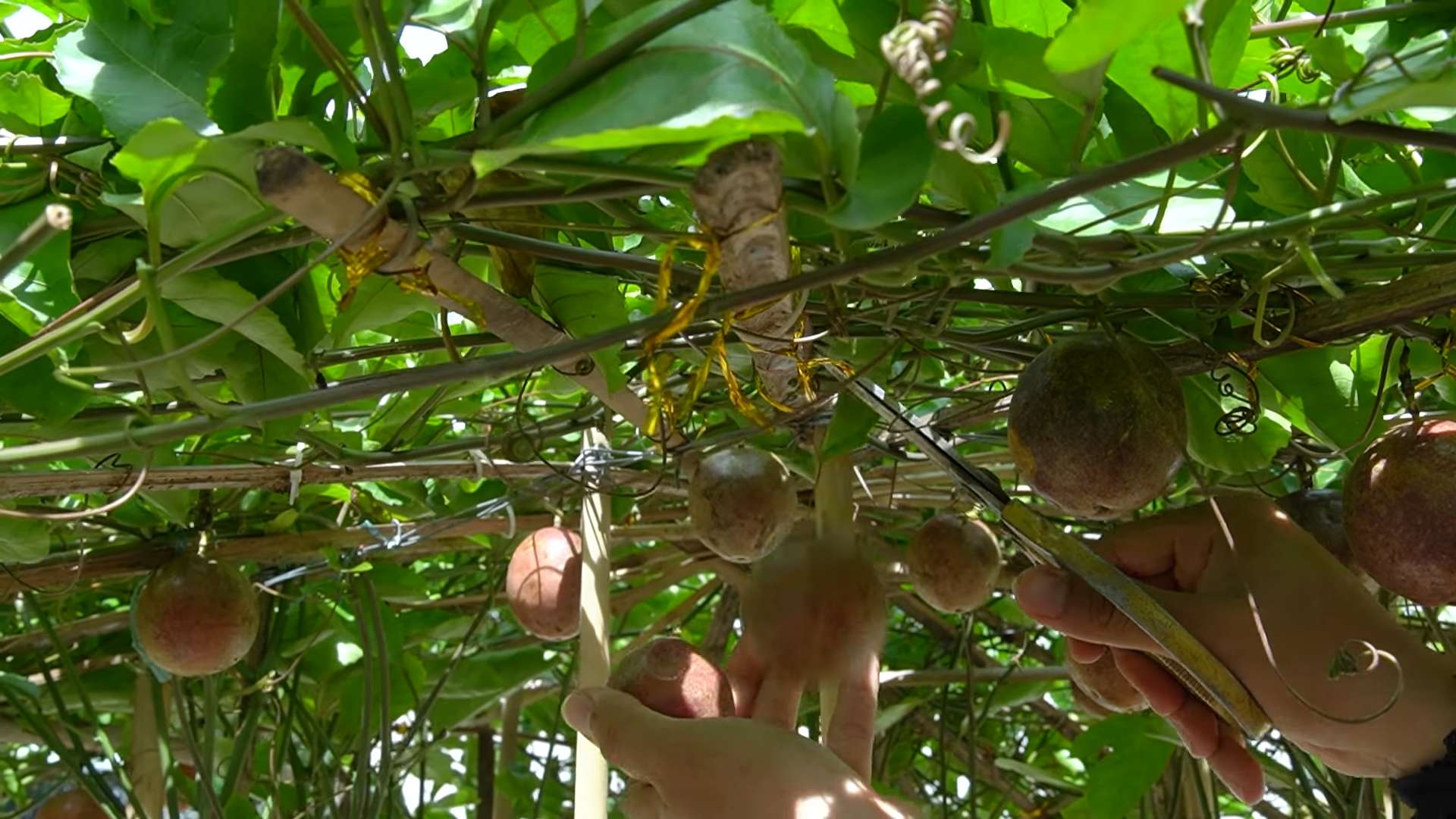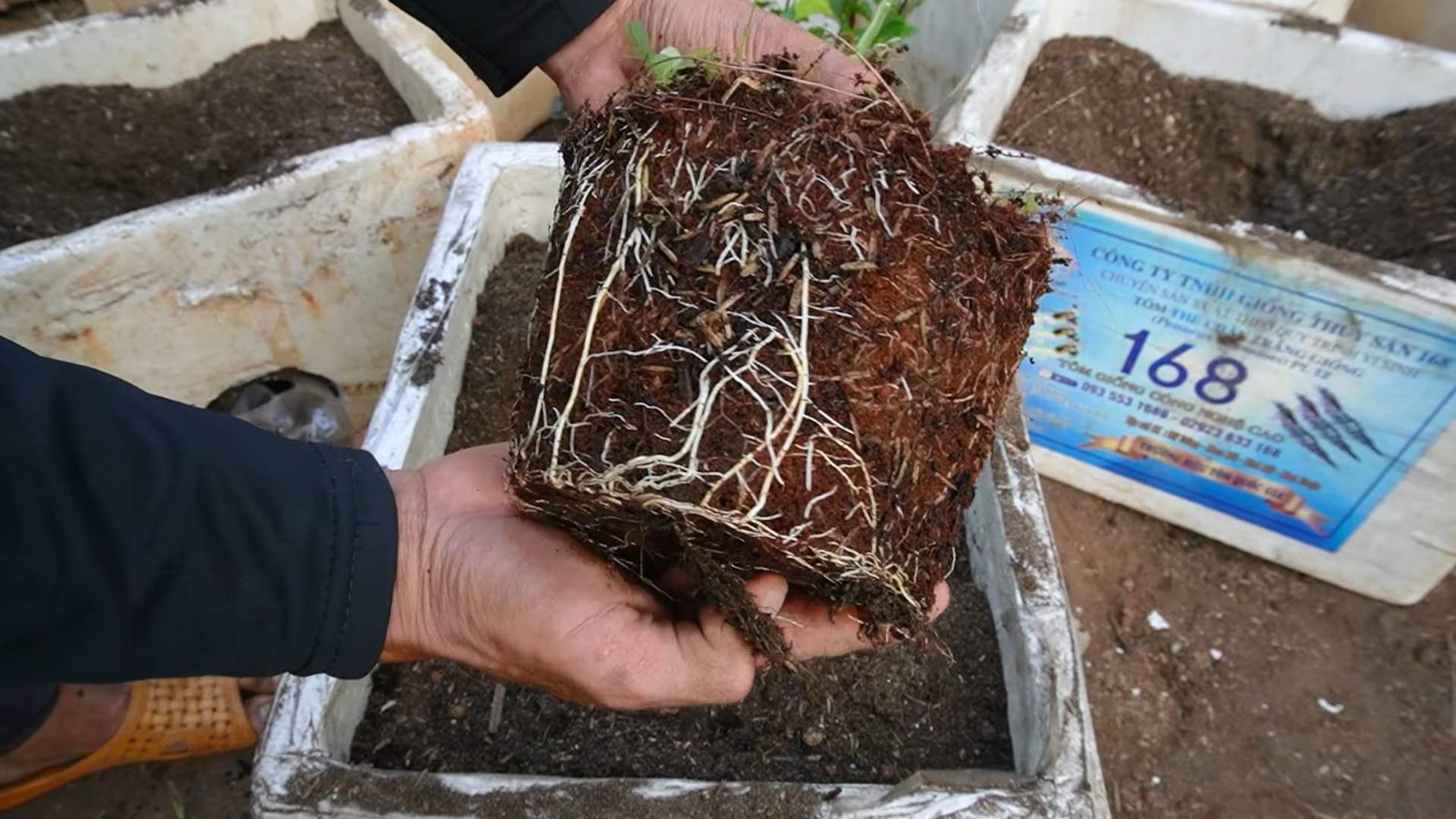Grow Passion Fruit at Home and transform your garden into a tropical paradise! Imagine plucking sweet, tangy passion fruit straight from your own vine – a dream that’s surprisingly easy to achieve with a few simple tricks. For centuries, passion fruit has been cherished in South America, not just for its delicious flavor but also for its purported medicinal properties. Indigenous cultures used it in traditional remedies, and its vibrant flowers held symbolic meaning.
But why should you bother learning to grow passion fruit at home? Well, store-bought passion fruit can be expensive and often lacks the intense flavor of homegrown varieties. Plus, there’s immense satisfaction in nurturing a plant from seedling to fruit-bearing vine. I’m here to guide you through some clever DIY hacks that will help you cultivate thriving passion fruit, even if you have limited space or gardening experience. From choosing the right variety for your climate to creating the perfect support structure, I’ll share my secrets to ensure a bountiful harvest. Get ready to embark on a rewarding gardening adventure and enjoy the exotic taste of passion fruit, fresh from your own backyard!

Growing Passion Fruit at Home: A DIY Guide
Hey there, fellow gardening enthusiasts! I’m so excited to share my experience with growing passion fruit at home. It’s a rewarding process, and trust me, nothing beats the taste of homegrown passion fruit. This guide will walk you through everything you need to know, from choosing the right variety to harvesting your delicious fruit. Let’s get started!
Choosing Your Passion Fruit Variety
Before we dive into the nitty-gritty, let’s talk about choosing the right passion fruit variety. There are several types, each with its own unique characteristics. Here’s a quick rundown:
* **Purple Passion Fruit (Passiflora edulis):** This is the most common variety, known for its small, dark purple fruit with a tangy-sweet flavor. It’s a great choice for beginners.
* **Yellow Passion Fruit (Passiflora edulis flavicarpa):** This variety produces larger, yellow fruit that’s more acidic than the purple type. It’s often used in juices and processed products.
* **Giant Granadilla (Passiflora quadrangularis):** As the name suggests, this variety produces very large fruit, but it’s less common and can be more challenging to grow.
* **Sweet Granadilla (Passiflora ligularis):** This variety has a sweeter, less acidic flavor than the other types. The skin is orange when ripe.
For this guide, I’ll focus primarily on the purple passion fruit, as it’s the easiest to grow in most climates. However, the general principles apply to other varieties as well.
Preparing for Planting
Okay, so you’ve chosen your variety. Now it’s time to get ready for planting. This involves selecting the right location, preparing the soil, and choosing your planting method.
* **Location, Location, Location:** Passion fruit vines need at least 6-8 hours of direct sunlight per day. Choose a spot in your garden that gets plenty of sun. Also, consider the vine’s mature size. They can grow quite large, so make sure you have enough space for them to spread. A trellis, fence, or pergola is essential for support.
* **Soil Preparation is Key:** Passion fruit vines prefer well-draining soil that’s rich in organic matter. Before planting, amend your soil with compost, aged manure, or other organic materials. This will improve drainage, fertility, and overall soil health. Aim for a slightly acidic to neutral soil pH (around 6.0-7.0). You can test your soil pH with a simple soil testing kit.
* **Starting from Seed vs. Seedling:** You can grow passion fruit from seed, but it’s generally easier and faster to start with a seedling from a nursery. If you’re starting from seed, be patient! It can take several weeks or even months for the seeds to germinate. Soak the seeds in warm water for 24-48 hours before planting to improve germination rates. Plant the seeds about 1/2 inch deep in a seed-starting mix. Keep the soil moist and warm (around 70-80°F). Once the seedlings are large enough to handle, transplant them into individual pots.
Planting Your Passion Fruit Vine
Alright, let’s get our hands dirty! Here’s how to plant your passion fruit vine:
1. **Dig the Hole:** Dig a hole that’s twice as wide and as deep as the root ball of your seedling.
2. **Amend the Soil (Again!):** Mix some compost or aged manure into the soil you removed from the hole.
3. **Carefully Remove the Seedling:** Gently remove the seedling from its pot, being careful not to damage the roots. If the roots are tightly bound, gently loosen them with your fingers.
4. **Position the Seedling:** Place the seedling in the hole, making sure the top of the root ball is level with the surrounding soil.
5. **Backfill the Hole:** Fill the hole with the amended soil, gently tamping it down to remove any air pockets.
6. **Water Thoroughly:** Water the newly planted vine thoroughly to help settle the soil.
7. **Mulch Around the Base:** Apply a layer of mulch around the base of the vine to help retain moisture, suppress weeds, and regulate soil temperature. Use organic mulch such as straw, wood chips, or shredded leaves. Keep the mulch a few inches away from the stem to prevent rot.
8. **Provide Support:** Immediately after planting, make sure the vine has access to its trellis, fence, or other support structure. Gently guide the vine towards the support and tie it loosely with soft twine or plant ties.
Caring for Your Passion Fruit Vine
Now that your passion fruit vine is planted, it’s time to provide the care it needs to thrive. This includes watering, fertilizing, pruning, and pest control.
* **Watering Wisely:** Passion fruit vines need consistent moisture, especially during hot, dry weather. Water deeply and regularly, but avoid overwatering, which can lead to root rot. Check the soil moisture regularly by sticking your finger into the soil. If the top inch or two feels dry, it’s time to water.
* **Fertilizing for Growth:** Passion fruit vines are heavy feeders, so regular fertilization is essential for healthy growth and abundant fruit production. Use a balanced fertilizer (e.g., 10-10-10) or a fertilizer specifically formulated for fruit trees. Fertilize every 4-6 weeks during the growing season (spring and summer). Follow the instructions on the fertilizer label for application rates. You can also supplement with organic fertilizers such as compost tea or fish emulsion.
* **Pruning for Productivity:** Pruning is important for maintaining the shape of the vine, promoting air circulation, and encouraging fruit production. Prune in late winter or early spring, before new growth begins. Remove any dead, damaged, or diseased branches. Also, prune back any overly vigorous growth to maintain a manageable size. Passion fruit vines produce fruit on new growth, so avoid pruning too heavily, as this can reduce fruit production.
* **Pest and Disease Control:** Passion fruit vines can be susceptible to various pests and diseases, including aphids, spider mites, scale, and fungal diseases. Regularly inspect your vine for signs of pests or diseases. If you spot any problems, take action promptly. For aphids and spider mites, you can try spraying the vine with a strong stream of water or using insecticidal soap. For scale, you can try scraping them off with a soft brush or using horticultural oil. For fungal diseases, ensure good air circulation and avoid overwatering. You can also use a fungicide if necessary.
Pollination and Fruit Set
Passion fruit flowers are beautiful and fragrant, but they need to be pollinated in order to produce fruit.
* **Hand Pollination (If Needed):** In some areas, natural pollinators may not be abundant enough to ensure good fruit set. In this case, you may need to hand-pollinate the flowers. To do this, use a small paintbrush to transfer pollen from the anthers (the male part of the flower) to the stigma (the female part of the flower). The best time to hand-pollinate is in the morning, when the flowers are fully open.
* **Attracting Pollinators:** You can also attract pollinators to your garden by planting flowers that they love, such as lavender, salvia, and bee balm. Avoid using pesticides that can harm pollinators.
Harvesting Your Passion Fruit
The moment you’ve been waiting for! Harvesting your passion fruit is the most rewarding part of the process.
* **When to Harvest:** Passion fruit is typically ready to harvest when the fruit changes color (from green to purple or yellow, depending on the variety) and falls to the ground. You can also gently tug on the fruit; if it comes off easily, it’s ripe.
* **How to Harvest:** Simply pick up the fallen fruit from the ground. If the fruit is still on the vine, gently twist it until it comes loose.
* **Storing Your Harvest:** Passion fruit can be stored at room temperature for a few days or in the refrigerator for up to a week. The skin may become wrinkled, but this doesn’t affect the flavor of the fruit.
Troubleshooting Common Problems
Even with the best care, you may encounter some problems along the way. Here are a few common issues and how to address them:
* **Lack of Fruit:** This can be caused by several factors, including insufficient sunlight, poor pollination, lack of fertilizer, or improper pruning. Make sure your vine is getting enough sunlight, hand-pollinate the flowers if necessary, fertilize regularly, and prune properly.
* **Yellowing Leaves:** This can be a sign of nutrient deficiency, overwatering, or pest infestation. Check the soil moisture and drainage, fertilize with a balanced fertilizer, and inspect the vine for pests.
* **Root Rot:** This is caused by overwatering and poor drainage. Make sure your soil is well-draining and avoid overwatering. If you suspect root rot, you can try transplanting the vine to a new location with better drainage.
Enjoying Your Homegrown Passion Fruit
Now that you’ve harvested your passion fruit, it’s time to enjoy the fruits of your labor!

Conclusion
So, there you have it! Growing passion fruit at home, while it might seem like a tropical dream, is absolutely achievable with a little know-how and dedication. We’ve walked you through the essential steps, from selecting the right variety and preparing the perfect soil to providing the necessary support and patiently waiting for those vibrant vines to flourish.
Why is this DIY trick a must-try? Because beyond the sheer satisfaction of nurturing a plant from seedling (or cutting!) to fruit-bearing glory, you’re gaining access to a flavor explosion that store-bought passion fruit simply can’t match. Imagine the intense, tangy-sweet aroma filling your kitchen as you slice open a perfectly ripe, homegrown passion fruit. Think of the countless culinary possibilities – from refreshing juices and exotic cocktails to decadent desserts and savory sauces. You’re not just growing fruit; you’re cultivating an experience.
But the benefits extend beyond the culinary realm. Passion fruit vines are beautiful, adding a touch of tropical elegance to your garden or balcony. They can provide shade, create a natural privacy screen, and even attract pollinators to your yard. Plus, engaging in gardening is a fantastic way to relieve stress, connect with nature, and learn something new.
Don’t be afraid to experiment! Consider these variations to personalize your passion fruit growing journey:
* Vertical Gardening: If you’re short on space, train your passion fruit vine to grow vertically on a trellis, fence, or even a wall. This is a great way to maximize your yield in a small area.
* Container Gardening: Choose a large container with good drainage and use a high-quality potting mix. This allows you to move your passion fruit plant indoors during colder months, extending its growing season.
* Different Varieties: Explore the different varieties of passion fruit available. Some are sweeter, some are more tart, and some have different colored fruits. Experiment to find your favorite!
* Companion Planting: Plant herbs like basil or rosemary near your passion fruit vine to deter pests and attract beneficial insects.
Ultimately, the key to success lies in patience and observation. Pay attention to your plant’s needs, adjust your care routine as necessary, and don’t be discouraged by setbacks. Growing passion fruit at home is a rewarding journey, and the delicious fruit you harvest will be well worth the effort.
We wholeheartedly encourage you to give this DIY trick a try. Start small, learn as you go, and most importantly, have fun! And once you’ve tasted the fruits (literally!) of your labor, we’d love to hear about your experience. Share your photos, tips, and stories in the comments below. Let’s create a community of passionate passion fruit growers! This method of growing **passion fruit at home** is sure to bring you joy.
Frequently Asked Questions (FAQ)
What is the best time of year to plant passion fruit?
The best time to plant passion fruit is typically in the spring or early summer, after the last frost has passed. This gives the plant ample time to establish itself and grow before the cooler months arrive. In warmer climates with mild winters, you can plant passion fruit year-round. However, avoid planting during periods of extreme heat or cold.
How long does it take for passion fruit to bear fruit?
Passion fruit plants typically take 12-18 months to begin producing fruit from seed. If you start with a cutting from a mature plant, you may see fruit sooner, potentially within 6-12 months. Factors such as climate, soil conditions, and the specific variety can also influence the time it takes for the plant to bear fruit. Be patient and provide proper care, and you’ll be rewarded with delicious passion fruit in due time.
What kind of soil is best for passion fruit?
Passion fruit thrives in well-draining soil that is rich in organic matter. A slightly acidic to neutral pH (around 6.0-7.0) is ideal. Amend heavy clay soils with compost, peat moss, or other organic materials to improve drainage and aeration. Sandy soils can be improved by adding organic matter to help retain moisture and nutrients. A good quality potting mix is suitable for container-grown passion fruit.
How much sunlight does passion fruit need?
Passion fruit requires at least 6-8 hours of direct sunlight per day to thrive and produce abundant fruit. Choose a sunny location in your garden or on your balcony where the plant will receive plenty of sunlight. If you live in a very hot climate, some afternoon shade may be beneficial to prevent the leaves from scorching.
How often should I water passion fruit?
Water passion fruit regularly, especially during dry periods. The soil should be kept consistently moist but not waterlogged. Water deeply when the top inch of soil feels dry to the touch. Reduce watering during the winter months when the plant is not actively growing. Overwatering can lead to root rot, so ensure the soil has good drainage.
What kind of fertilizer should I use for passion fruit?
Passion fruit benefits from regular fertilization, especially during the growing season. Use a balanced fertilizer with a ratio of 10-10-10 or 14-14-14. Apply the fertilizer according to the manufacturer’s instructions. You can also supplement with organic fertilizers such as compost tea or fish emulsion. Avoid over-fertilizing, as this can damage the plant.
How do I prune passion fruit?
Pruning is essential for maintaining the health and productivity of passion fruit vines. Prune regularly to remove dead, diseased, or overcrowded growth. You can also prune to control the size and shape of the vine. The best time to prune is after the main fruiting season. Avoid heavy pruning, as this can reduce fruit production.
What are common pests and diseases that affect passion fruit?
Passion fruit can be susceptible to various pests and diseases, including aphids, spider mites, scale insects, and fungal diseases like fusarium wilt and root rot. Regularly inspect your plant for signs of pests or diseases. Treat infestations with insecticidal soap or neem oil. Prevent fungal diseases by ensuring good air circulation and avoiding overwatering.
How do I know when passion fruit is ripe?
Passion fruit is ripe when the fruit changes color from green to purple, yellow, or red, depending on the variety. The fruit will also become slightly wrinkled and have a fragrant aroma. Ripe passion fruit will often fall from the vine on its own. You can also gently tug on the fruit to see if it comes off easily.
Can I grow passion fruit indoors?
Yes, you can grow passion fruit indoors, but it requires specific conditions. Provide plenty of sunlight, either through a sunny window or with grow lights. Use a large container with good drainage and a high-quality potting mix. Water regularly and fertilize during the growing season. You may need to hand-pollinate the flowers to ensure fruit production. Indoor-grown passion fruit may not produce as much fruit as those grown outdoors.
How do I pollinate passion fruit flowers?
Passion fruit flowers are typically pollinated by bees and other insects. However, if you’re growing passion fruit indoors or in an area with limited pollinators, you may need to hand-pollinate the flowers. Use a small paintbrush to transfer pollen from the stamen (male part) to the pistil (female part) of the flower. Hand-pollinate in the morning when the flowers are open.
My passion fruit plant is flowering, but not producing fruit. What could be the problem?
There are several reasons why your passion fruit plant may be flowering but not producing fruit. Insufficient pollination is a common cause. Make sure the flowers are being pollinated by bees or other insects, or hand-pollinate them yourself. Other factors include nutrient deficiencies, lack of sunlight, or stress from extreme temperatures or drought. Ensure your plant is receiving proper care and address any underlying issues.
Can I grow passion fruit from seed?
Yes, you can grow passion fruit from seed, but it may take longer to bear fruit compared to starting with a cutting. Soak the seeds in water for 24 hours before planting. Sow the seeds in a well-draining potting mix and keep them moist. Germination can take several weeks. Once the seedlings are large enough to handle, transplant them into individual pots.
Is passion fruit self-pollinating?
Some varieties of passion fruit are self-pollinating, while others require cross-pollination with another variety. If you’re unsure whether your variety is self-pollinating, it’s best to plant two different varieties to ensure fruit production.
How do I store passion fruit?
Ripe passion fruit can be stored at room temperature for a few days. For longer storage, refrigerate the fruit in a plastic bag for up to 2-3 weeks. You can also freeze the pulp for later use. Simply scoop out the pulp and freeze it in ice cube trays or freezer bags.




Leave a Comment